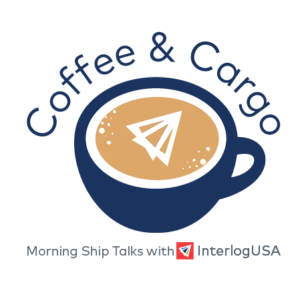Competitive Edge
September 28th, 2022
Stay Current with Interlog’s Weekly Newsletter:


UPDATE: U.S./Canada Ports – Number of Vessels at Anchor as of 09-27-22
- Vancouver: 39 Vessels at Anchor (-2)
- Houston: 32 Vessels at Anchor (-2)
- Savannah: 30 Vessels at Anchor (+2)
- San Francisco/Oakland: 9 Vessels at Anchor (+4)
- New York/Newark: 8 Vessels at Anchor (-8)
- Los Angeles/Long Beach: 8 Vessels at Anchor (-1)
- Mobile: 5 Vessels at Anchor (-7)
- Charleston: 3 Vessels at Anchor (-2)
Note: This count does not include vessels moored and being unloaded at port docks. Colored numbers in parentheses represents the change from last week over.
Courtesy: MarineTraffic
Takeaways
- U.S. West Coast: Not only is the congestion down, it’s also been consistent with little change week over week. Clearly, the U.S. WC is most the stable of the three in respects to vessel congestion.
- U.S. Gulf Coast: Houston remains to be the epicenter of congestion for the Gulf (and the U.S. this week).
- U.S. East Coast: The U.S. EC continues to be at the forefront of vessel congestion, headlined by Savannah.
- New York/Newark has enjoyed a notable drop in vessels at anchor. This could be an indicator of carriers weary to call with concerns to the port’s proposed dwell fee on sitting containers. However, this is just speculation right now. We will see if this number sustains week-over-week over the next month.
- Canada: The Canadian West Coast ports are at near yard capacity. Vancouver and Prince Rupert have been subject to vessel berthing delay issues.
IMPORT: Asia to North America (TPEB)
Recent Developments:
- China’s Golden Week begins next week, October 1 through October 7. Factories in China are closed during this time.
- The holiday’s typical impacts to capacity and rates are not as significant when compared to last year.
- There’s growing optimism around intermodal delays and inland congestion with railroad strikes called-off after a tentative labor deal was met. Some shippers are weary though if rail service will improve from this deal alone.
- Contract negotiations between the International Longshore and Warehouse Union (ILWU) and Pacific Maritime Association (PMA) remain active. The existing labor contract between the two parties expired July 1.
- ILWU members at the ports of Oakland and Seattle-Tacoma engaged in job actions that slowed down cargo-handling operations.
- Blank sailings are becoming more commonplace as carriers aim to cut down on port congestion, especially on USEC.
Rates: Rates continue to fall. Notably from Chinese base ports to all U.S. coasts.
Space: Space is generally open at this time.
Capacity: Capacity has tightened in pockets. Shippers continue to divert cargo to the USEC and USGC due to fears of disruptions at West Coast ports from ongoing labor talks.
Equipment: Some inland terminals are reaching max capacity with inventory. Intermodal systems remain stressed with congestion and truck and chassis deficits.
TIPS:
- Book at least two weeks prior to the ready date.
- For cargo ready now, take advantage of opening space and fallen rates on the spot market.
- Reconsider averting West Coast routings. The “hot spots” for ship congestion and vessel wait times has shifted to the East Coast.
IMPORT: Europe to North America (TAWB)
Recent Developments:
- Northern European hubs, such as Rotterdam, Antwerp, and Hamburg, remain congested.
- Labor-related tensions remain gripping the U.K’s ports as unions dispute over a new pay deal that matches inflation rates.
- Around 1,900 dockworkers at Britain’s largest container port, Felixstowe, have begun their second walkout yesterday and will do so until October 5.
- Some 560 dockworkers at Britain’s Port of Liverpool are on strike and will continue until October 3.
- USWC ports have seen port and yard congestion and improvements to vessel waiting times.
- On the USEC, both ports of New York/Newark and Savannah remain having a significant number of backlogged vessels at anchor off their respective shores.
- The Port of Houston, on the U.S. Gulf Coast, is also grappling with vessel congestion.
Rates: Rates have seen some decreases. However, not at the same clip as other trade lanes.
Space: Space remains tight to the USEC. However, space has opened for direct routings to the USWC.
Capacity: Capacity for both North Europe and Mediterranean services remain gripped. Low water level of Germany’s Rhine River continues and both terminals experience a shift from barge to truck capacity for import and export delivery/pick-up.
Equipment: Equipment at European seaports is not as readily available as it has been for the past few months. Inland terminals in Europe are also still reporting equipment shortages. On the U.S. side, truck and chassis availability remain concerning, especially with the latter.
TIPS:
- Book five or more weeks prior to ready date.
- Strongly consider premium services for no-roll options and improved reliability of cargo.
- Be flexible and entertain alternative routings. They could cut back on wait times and/or costs.
EXPORT: North America to Asia
Recent Developments:
- For the USEC, port congestion remains an issue for Savannah and New York/Newark
- Diminished schedule integrity continues to challenge post earliest return dates.
- Vessel arrivals remain smooth for USWC POLs.
Rates: So far, no GRIs announced for October.
Capacity: Available capacity remains fluid for USWC POLs.
Equipment: Truck, container, and chassis availability remains dire and has significantly contributed to congestion of the intermodal system and IPI origins. Standard equipment at ports remains available unless carriers advise otherwise.
TIPS:
- Book four to five weeks prior to the time of departure to secure necessary equipment and vessel space.
Did You Know: Shanghai International Port Group (SIPG) is Investing $7 Billion into a New Shanghai Container Terminal
This new facility is expected to handle an annual capacity of 11.5 million twenty-foot equivalent units (TEUs).
Additionally, this new facility will have seven berths for ships up to 70,000 tons and 15 berths for 20,000 ton vessels, as well as container yards and anchorages to help support.
The completion for this new container terminal in Shanghai is expected in 2030.
Source: Journal of Commerce
Freight News
Officials at the Port of Vancouver seeing signs of easing
The CEO and President of the Port of Vancouver, Robin Silvestor, is optimistic that signs are showing some ease through the congested rail networks in Canada to hubs in Toronto and Montreal.
Right now, reports are showing rail container dwell time of 5 days in August was down from 6.6 days in July – even though it still is higher than the average three-day dwells of last fall. You might also remember last December, when rail container dwell times peaked at 8.1 days after terrible floods in British Columbia.
Things aren’t perfect at the Port of Vancouver, but congestion metrics are looking relatively optimistic.
Silvestor noted that the backlog of container ships waiting to berth have dipped; down to 3 this week after seeing highs in the 30s this spring. Additionally, average truck turn times at all 4 container terminals remain a bit above 40 minutes, but he told the JOC that’s ‘good’ in terms of port standards on the USWC.
Also, total laden and empty container throughput in Vancouver fell 4.1 percent year-over-year in the first eight months of this year, the JOC notes. Silvestor also said he expects container volumes to edge higher throughout the last remaining months of this year.
East Gulf Coastal Updates: Georgia Ports Authority implementing a new tariff starting October 1st. Plus, what we know so far about Hurricane Ian
New Tariff at the Port of Savannah:
In an effort to incentivize and push ocean carriers to sweep up more empty containers from the Port of Savannah, the GPA is releasing a new marine terminal tariff (through rules and fees) on October 1st.
This new tariff will lower the number of empty containers that ocean carriers are allowed to store each month at both the Savannah port and the inland Appalachian Regional Port, as well as storing empties that exceed those allotments – the Journal of Commerce reports.
The GPA will also introduce tiered fees from $10 to $25 per day, for each empty container above the new inventory threshold. This comes after the previous tariff charged $4 per day for empty container storage.
Hurricane Ian:
Hurricane Ian, just shy of a Category 5 (as of now), is making its way to Florida, particularly near the Fort Myers area. Right now, reports are showing that Tampa Bay may have averted the worst of the storm surge, but areas near the gulf coast are still in the ‘bulls-eye’ of heavy rainfall, throughout the next two days.
Many urge that residents throughout the peninsula should be prepared for hurricane-like conditions. Freightwaves notes that the wind field is very wide with this storm and the impacts, especially from the rain, will be felt throughout the entire state. Additionally, the Florida Governor issued an emergency order that will be in effect for at least the next 60 days. The emergency order will waive hours-of-service, size, and weight restrictions for trucks delivering emergency supplies and equipment.
It’s hard to speculate what impacts this Hurricane will have on the supply chain, but citrus growers, manufacturers and marine terminals are all at high risk of damage and delays. We will continue to monitor this situation and update when necessary.
Sign Up for Next Month's Webinar!

Make sure you sign up for our next webinar that is taking place on Wednesday, October 19th! We will be discussing current and exciting topics in the freight industry.
If you have never joined our Coffee and Cargo webinar, click the "Watch Now" button to view our most recent Webinar.
We look forward to seeing you there!
Sign up for our
industry answers
Our team works to provide valuable, unique, and relevant content to assist you in finding solutions. Sign up now.

